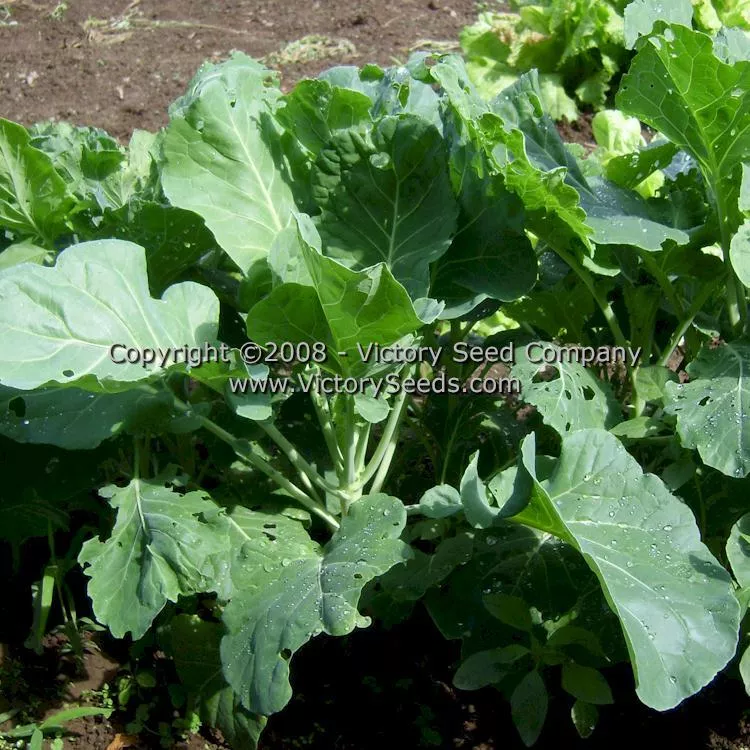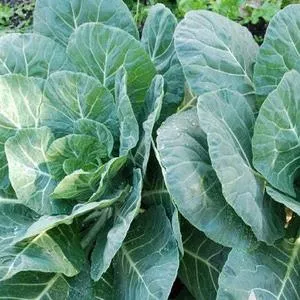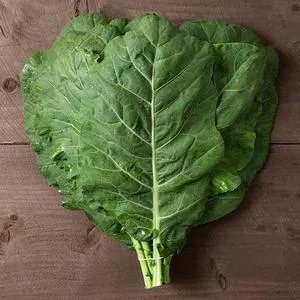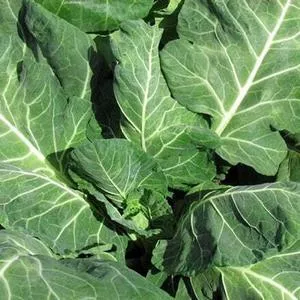Morris Heading Collards
Brassica oleracea
Price: $3.25
SKU: 3130021Choose a variant:
79 days - An old-time heirloom favorite, 'Morris Heading' plants are mostly large in stature but population do tend to be highly variable in size and color; ranging from green to very blue-green. The fast-growing stalks can reach twenty-four to thirty-six inches tall, are slow to bolt, and produce broad, wavy leaves that maintain a mild flavor. Many plants will form leafy heads late in growing season.
Bred by the Morris Plant Farm of Hasty, North Carolina, 'Morris Heading' was introduced around 1919.[1]
Bred by the Morris Plant Farm of Hasty, North Carolina, 'Morris Heading' was introduced around 1919.[1]
Genetic Classification: Open Pollinated
Cultivation Instructions:
In the Southern United States, sow in mid-July to late summer for winter and spring harvests. In colder climates, when the soil temps are between 50ºF and 80ºF, sow in late spring for a fall harvest. Sow seeds ¼ to ½ inch deep, in rows spaced three feet apart, and cover with fine soil. Depending on the conditions, germination occurs in six to eighteen days.
Thin seedlings to six inches apart and allow them to continue to grow. Once those plants get large enough to touch each other, harvest whole plants by cutting at the soil line resulting in a final spacing for your collards of about eighteen inches between the plants. Give them room as they tend to grow large.
Harvest Tips:
Growing from a main stalk, collard leaves radiate outward from tough, inedible stalks. Their individual leaves should be harvested from the bottom of the stalks upwards before they are full-sized when they become tough and woody. Collard greens tend to store better than most other greens. Harvest but do not wash prior to storage. Simply wrap the unwashed leaves in moist paper towels and place in sealed containers. Prior to use, wash thoroughly.
If you maintain good soil moisture during the summer's hot periods, control insects, and regularly harvest leaves, collards will reward you with an abundant harvest.
Cooked collards can have a bitter flavor but it is enhanced when served with vinegar. Flavored vinegar, for example, the "juice" from a jar of pickled vegetables, are quite tasty. You might also like to try combing with sun-dried tomatoes, onions, garlic, or crushed red pepper for seasoning. Have fun and experiment!
In the Southern United States, sow in mid-July to late summer for winter and spring harvests. In colder climates, when the soil temps are between 50ºF and 80ºF, sow in late spring for a fall harvest. Sow seeds ¼ to ½ inch deep, in rows spaced three feet apart, and cover with fine soil. Depending on the conditions, germination occurs in six to eighteen days.
Thin seedlings to six inches apart and allow them to continue to grow. Once those plants get large enough to touch each other, harvest whole plants by cutting at the soil line resulting in a final spacing for your collards of about eighteen inches between the plants. Give them room as they tend to grow large.
Harvest Tips:
Growing from a main stalk, collard leaves radiate outward from tough, inedible stalks. Their individual leaves should be harvested from the bottom of the stalks upwards before they are full-sized when they become tough and woody. Collard greens tend to store better than most other greens. Harvest but do not wash prior to storage. Simply wrap the unwashed leaves in moist paper towels and place in sealed containers. Prior to use, wash thoroughly.
If you maintain good soil moisture during the summer's hot periods, control insects, and regularly harvest leaves, collards will reward you with an abundant harvest.
Cooked collards can have a bitter flavor but it is enhanced when served with vinegar. Flavored vinegar, for example, the "juice" from a jar of pickled vegetables, are quite tasty. You might also like to try combing with sun-dried tomatoes, onions, garlic, or crushed red pepper for seasoning. Have fun and experiment!
Informational References:
- "Vegetable Cultivar Descriptions for North America – Collards, Lists 1-27 Combined," Edited by Mark W. Farnham, USDA/ARS Vegetable Laboratory, Charleston, SC 29414.
Customer Reviews:
Do you have experience with this one? 📝 📣 Write a review!
★★★★★ Great taste; semisweet flavor. Yummmmmy!
By Joseph Miller on March 19, 2022
By Joseph Miller on March 19, 2022
Great taste; semisweet flavor. Picking small heads stem and surrounding leaf boiled in salted water till tender. Yummmmmy!




